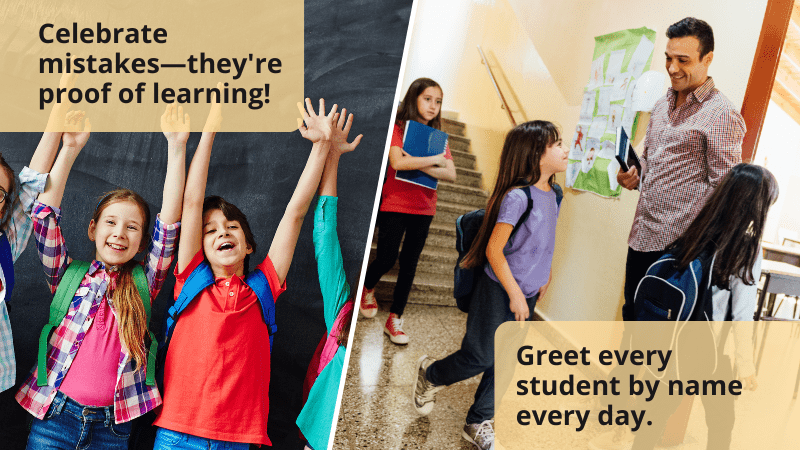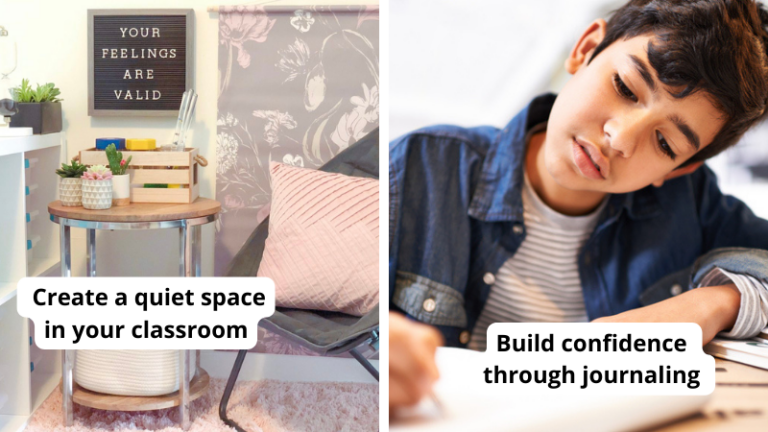Ready to feel a bit intimidated? According to the PEW Research Center, the American Academy of Pediatrics, the American Academy of Child and Adolescent Psychiatry, and the Children’s Hospital Association, the pandemic-related decline in child and adolescent mental health is a national health emergency. That’s huge. Especially since we know that teachers, yet again, are going to be asked to step up and play a major role in tackling this new challenge. So what can we do? How can we start to repair some of the damage caused by these tough years, while we support and build healthy student minds in our classrooms each day? The National PTA has lots of excellent resources to help you make mental health a priority in your classroom. Here are 17 easy ways they share to get you started.

Yes, we have attendance, planning, and emails in the morning. But eye contact, a positive hello, and a check-in are actions that make students feel seen, and they’re a way for you to see how students are arriving to school and what they might need.

Students are so much more than what we see in school. Get to know about their lives by asking questions and listening closely, doing interest inventories and activities, a Who Am I? biography, identity activities, and self-portrait projects, and promote regular sharing about their lives in advisory or morning meeting.

All of our students have aspirations. They are all humans with dreams, interests, and strengths. Focus on what they can do and who they are right now. Notice, and tell them. You might be the only one who has noticed, and this can change how they feel about themselves.

Of course you want to accomplish the full lesson you planned out. Or for students to do something in a way that you had planned. But students right now really need for us to be flexible. Can the assignment be done in another way? If a student struggles to stay in their seat, can they sit on the floor on a beanbag instead? Can a student who had a bad morning go back and try that work again when they’re feeling better? It might take some rearranging on our part, but this willingness to change course when necessary with help build healthy student minds.

Each day, our students are coming to school with additional needs, especially now. It might be a space to do some personal care (brushing teeth and hair), it might be a clean sweatshirt. It might be some calm coloring or music to start the day. What is a way they can enter their day in a positive way?

The pandemic has led to chronic fear and exhaustion for many of us. Many students don’t have the endurance for high levels of engagement and concentration the way they used to. We need to build this, of course, but in the meantime, students need mental and physical breaks. Movement, interaction, and levity (a game or other silliness) helps students feel belonging and promotes their engagement in class.

Humans love choices. We feel more ownership when we are part of a decision. Teachers can provide more choices for students so they feel more agency and in charge of their lives. They can pick from choices on a math menu. They can pick from project choices to communicate what they are learning. At least some of the world and their experience is now in their control.

It’s easy to feel isolated as a teacher. But remember that everyone in the building is there to help students, not to mention the additional support of community-based organizations. Get your behavior interventionists, guidance counselor, custodian, special educator, office staff, and unified arts teachers communicating regularly with one another to support students. They can help you find what you need—be it office supplies, food, health items, games, or other resources.

I know, it is hard to keep up communication with families. But sending a quick email about something awesome a student did can take one minute. And it helps families know you are working together to help their child. Also, families might not have access to all the information from the school. Weekly emails/newsletters help, and so does flexibility around conferences, which can be held via phone, virtually, or in person.

Don’t underestimate the power of this one. Some students are uncomfortable with eating in the cafeteria, or they are not given enough food. Sometimes they are taking a snack for later. I coordinated with my families to have a constant supply of snacks in the closet and it helped all students, especially those kids who were too busy to pack a snack or did not have enough food.

Keeping track of papers is difficult for many students (and adults!). Having digital options easily available by using Google Classroom or other apps like Seesaw helps when students are absent, moving between caregivers, or losing items. This will reduce stress and anxiety about keeping track of assignments.

Home lives are extremely busy, and caregivers are under a lot of stress. One way to ease this is to give limited or no homework. There is little research to support giving elementary students homework other than nightly reading. Your students will be able to sleep more, and they will have less to worry about outside of school.

Too often school is all business. How can classrooms have more joy? Jokes of the day. Wildlife cams. Playing music that your students love or even need. In frigid winter, I play beach music. On stressful days, calming acoustic. Use music, art, nature, and play to increase the joy. End the day well with a closing meeting that includes shout-outs and listing three good things about the day.

Our students have lost over a year of opportunities for face-to-face interactions. This is apparent in the struggles with collaborative projects, teamwork, and even play that teachers witnessed in the 2021–2022 school year. Through advisory or morning meeting, and through learning experiences and projects, give them more practice with social skills. They will grow and build relationships and a sense of community.

Building relationships with students is about doing small, kind actions over and over again all year long. Showing up for our students, listening to their stories, supporting them when they fail, giving them opportunities to try again. And repeat. It’s exhausting, but remember, you’re not the only adult your students can build relationships with at school. Give your students opportunities to connect with the other adults they engage with throughout the day. Your connection with one student might make all the difference to them, but for another student, the gym teacher, librarian, or custodian might be the one who brightens their day. The ultimate goal is to ensure students get the support they need. Help foster these relationships all year long.

Students need to see us teachers as full humans, just as we see them that way. If the lesson doesn’t go the way you wanted, or you wished you’d handled something differently, let the students know. Model appropriate, compassionate reactions when a student shares something hard or personal. This will build trust and model a way of living that is vulnerable and reflective.

Students want to belong, to feel safe, and to learn. We can promote this by allowing students to solve problems in their own ways, by celebrating what they are doing right, and creating a climate where mistakes are just part of learning and are normalized.
Teachers alone cannot heal the wounds the pandemic may have left behind (and everything that came before it). But we do know that the actions of one person can have a tremendous impact on others. For many of us, it’s a big part of why we love teaching—the knowledge that we make a difference in the lives of our students every day.

